Exploration of Thiamin thiazole synthase (THI4) Expression and Transcriptomes Involved in the Floral Volatiles of Caladium bicolor
Abstract
1. Introduction
2. Materials and Methods
2.1. Plant Materials
2.2. Sample Preparation and Data Analyses for RNA-seq
2.3. Cloning and Transient Expression of Caladium THI4 Promoter
2.4. Analysis of a Transgene Expression Driven by Caladium THI4 Promoter
3. Results
3.1. Predicted Transcript Analyses
3.2. Putative THI4 Regulatory Transcripts
3.3. Male Tissue-Specific Expression of Caladium THI4 Promoter in Tobacco and Petunia Plants
4. Discussion
4.1. Transcripts Associated with Secondary Metabolite Biosynthesis Showing High Expression Coincided with De Novo C. bicolor Volatiles Emission
4.2. The Other Possible Transcripts Associated with the Flower Development of C. bicolor
4.3. CbTHI4 Promoter Is a Male Tissue-Specific
5. Conclusions
Supplementary Materials
Author Contributions
Funding
Data Availability Statement
Conflicts of Interest
References
- Chatterjee, A.; Jurgenson, C.T.; Schroeder, F.C.; Ealick, S.E.; Begley, T.P. Thiamin biosynthesis in eukaryotes: Characterization of the enzyme-bound product of thiazole synthase from Saccharomyces cerevisiae and its implications in thiazole biosynthesis. J. Am. Chem. Soc. 2006, 128, 7158–7159. [Google Scholar] [CrossRef]
- Chatterjee, A.; Jurgenson, C.T.; Schroeder, F.C.; Ealick, S.E.; Begley, T.P. Biosynthesis of thiamin thiazole in eukaryotes: Conversion of NAD to an advanced intermediate. J. Amer. Chem. Soc. 2007, 129, 2914–2922. [Google Scholar] [CrossRef]
- Chatterjee, A.; Abeydeera, N.D.; Bale, S.; Pein-Jing, P.; Dorrestein, P.C.; Russell, D.H.; Ealick, S.E.; Begley, T.P. Saccharomyces cerevisiae THI4p is a suicide thiamine thiazole synthase. Nature 2011, 478, 542–546. [Google Scholar] [CrossRef] [PubMed]
- Yazdani, M.; Zallot, R.; Tunc-Ozdemir, M.; de Crécy-Lagard, V.; Shintani, D.K.; Hanson, A.D. Identification of the thiamin salvage enzyme thiazole kinase in Arabidopsis and maize. Phytochemistry 2013, 94, 68–73. [Google Scholar] [CrossRef] [PubMed]
- Sun, J.; Sigler, C.L.; Beaudoin, G.A.W.; Joshi, J.; Patterson, J.A.; Cho, K.H.; Ralat, M.A.; Gregory, J.F.; Clark, D.G.; Deng, Z.; et al. Parts-Prospecting for a High-Efficiency Thiamin Thiazole Biosynthesis Pathway. Plant Physiol. 2019, 179, 958–968. [Google Scholar] [CrossRef] [PubMed]
- Joshi, J.; Beaudoin, G.A.; Patterson, J.A.; García-García, J.D.; Belisle, C.E.; Chang, L.Y.; Li, L.; Duncan, O.; Millar, A.H.; Hanson, A.D. Bioinformatic and experimental evidence for suicidal and catalytic plant THI4s. Biochemical. J. 2020, 477, 2055–2069. [Google Scholar] [CrossRef] [PubMed]
- Gottsberger, G. Beetle Pollination and Flowering Rhythm of Annona spp. (Annonaceae) in Brazil. Plant System. Evol. 1989, 167, 165–187. [Google Scholar] [CrossRef]
- Maia, A.C.D.; Schlindwein, C. Caladium bicolor (Araceae) and Cyclocephala celata (Coleoptera, Dynastinae): A well-established pollination system in the northern Atlantic rainforest of Pernambuco, Brazil. Plant Biol. 2006, 8, 529–534. [Google Scholar] [CrossRef]
- Ratcliffe, B.C.; Paulsen, M.J. The Scarabaeoid Beetles of Nebraska. Univ. Nebraska. 2008, 22, 2–6. [Google Scholar]
- Maia, A.C.D.; Schlindwein, C.; Navarro, D.M.A.F.; Gibernau, M. Pollination of Philodendron acutatum (Araceae) in the Atlantic Forest of northeastern Brazil: A single scarab beetle species guarantees a high fruit set. Int. J. Plant Sci. 2010, 171, 740–748. [Google Scholar] [CrossRef]
- Gibernau, M. Pollinators and Visitors of Aroid Inflorescences: An Addendum. Aroideana 2011, 34, 70–83. [Google Scholar]
- Maia, A.C.D.; Dotterl, S.; Kaiser, R.; Silberbauer-Gottsberger, I.; Teichert, H.; Gibernau, M.; Amaral Ferraz Navarro, D.M.; Schlindwein, C.; Gottsberger, G. The Key Role of 4-methyl-5-vinylthiazole in the Attraction of Scarab Beetle Pollinators: A Unique Olfactory Floral Signal Shared by Annonaceae and Araceae. J. Chem. Eco. 2012, 38, 1072–1080. [Google Scholar] [CrossRef]
- Schmid, M.; Davison, T.S.; Henz, S.R.; Pape, U.J.; Demar, M.; Vingron, M.; Schölkopf, B.; Weigel, D.; Lohmann, J.U. A gene expression map of Arabidopsis thaliana development. Nat. Gen. 2005, 37, 501–506. [Google Scholar] [CrossRef]
- Ma, L.; Sun, N.; Liu, X.; Jio, Y.; Zhao, H.; Deng, X.W. Organ-Specific Expression of Arabidopsis Genome during Development. Plant Physiol. 2005, 138, 80–91. [Google Scholar] [CrossRef]
- Fang, F.C.; Rimsky, S. New insights into transcriptional regulation by H-NS. Curr. Opin. Microbiol. 2008, 11, 113–120. [Google Scholar] [CrossRef] [PubMed]
- Du, F.; Fan, J.; Wang, T.; Wu, Y.; Grierson, D.; Gao, Z.; Xia, Y. Identification of differentially expressed genes in flower, leaf and bulb scale of Lilium oriental hybrid ‘Sorbonne’ and putative control network for scent genes. BMC Gen. 2017, 18, 899. [Google Scholar] [CrossRef] [PubMed]
- Cao, Z.; Deng, Z. De Novo Assembly, Annotation, and Characterization of Root Transcriptomes of Three Caladium Cultivars with a Focus on Necrotrophic Pathogen Resistance/Defense-Related Genes. Int. J. Mol. Sci. 2017, 18, 712. [Google Scholar] [CrossRef] [PubMed]
- Chang, S.; Puryear, J.; Cairney, J. A simple and efficient method for isolating RNA from pine trees. Plant Mol. Biol. Rep. 1993, 11, 113–116. [Google Scholar] [CrossRef]
- Bolger, A.M.; Lohse, M.; Usadel, B. Trimmomatic: A flexible trimmer for Illumina Sequence Data. Bioinformatics 2014, 30, 2114–2120. [Google Scholar] [CrossRef]
- Huang, Y.; Niu, B.; Gao, Y.; Fu, L.; Li, W. CD-HIT Suite: A web server for clustering and comparing biological sequences. Bioinformatics 2010, 26, 680–682. [Google Scholar] [CrossRef]
- van Bel, M.; Proost, S.; van Neste, C.; Deforce, D.; van de Peer, Y.; Vandepoele, K. TRAPID: An efficient online tool for the functional and comparative analysis of de novo RNA-Seq transcriptomes. Genome Biol. 2013, 14, R134. [Google Scholar] [CrossRef] [PubMed]
- Kanehisa, M.; Sato, Y.; Kawashima, M.; Furumichi, M.; Tanabe, M. KEGG as a reference resource for gene and protein annotation. Nucleic Acids Res. 2016, 44, D457–D462. [Google Scholar] [CrossRef] [PubMed]
- Jin, J.; Tian, F.; Yang, D.C.; Meng, Y.Q.; Kong, L.; Luo, J.; Gao, G. PlantTFDB 4.0: Toward a central hub for transcription factors and regulatory interactions in plants. Nucleic Acids Res. 2017, 45, D1040–D1045. [Google Scholar] [CrossRef] [PubMed]
- Cho, K.H.; Kim, J.Y.; Alvarez, M.I.; Laux, V.Y.; Valad, L.K.; Tester, J.M.; Colquhoun, T.A.; Clark, D.G. Strong Fluorescence Expression of ZsGreen1 in Petunia Flowers by Agrobacterium tumefaciens–mediated Transformation. J. Amer. Soc. Hort. Sci. 2019, 144, 405–413. [Google Scholar] [CrossRef]
- Dong, J.; Ding, X.; Wang, S. Purification of the recombinant green fluorescent protein from tobacco plants using alcohol/salt aqueous two-phase system and hydrophobic interaction chromatography. BMC Biotech. 2019, 19, 1–8. [Google Scholar] [CrossRef] [PubMed]
- Jorgensen, W.L.; Maxwell, D.S.; Tirado-Rives, J. Development and testing of the OPLS all-atom force field on conformational energetics and properties of organic liquids. J. Amer. Chem. Soc. 1996, 118, 11225–11236. [Google Scholar] [CrossRef]
- Verdonk, J.C.; Ric de Vos, C.H.; Verhoeven, H.A.; Haring, M.A.; van Tunen, A.J.; Schuurink, R.C. Regulation of floral scent production in petunia revealed by targeted metabolomics. Phytochemistry 2003, 62, 997–1008. [Google Scholar] [CrossRef] [PubMed]
- Livak, K.J.; Schmittgen, T.D. Analysis of relative gene expression data. Methods 2001, 25, 402–408. [Google Scholar] [CrossRef]
- Higo, K.; Ugawa, Y.; Iwamoto, M.; Korenaga, T. Plant cis-acting regulatory DNA elements (PLACE) database: 1999. Nucleic Acids Res. 1999, 27, 297–300. [Google Scholar] [CrossRef]
- van Moerkercke, A.; Schauvinhold, I.; Pichersky, E.; Haring, M.A.; Schuurink, R.C. A plant thiolase involved in benzoic acid biosynthesis and volatile benzenoid production. Plant J. 2009, 60, 292–302. [Google Scholar] [CrossRef]
- Dao, T.T.H.; Linthorst, H.J.M.; Verpoorte, R. Chalcone synthase and its functions in plant resistance. Phytochem. Rev. 2011, 10, 397–412. [Google Scholar] [CrossRef] [PubMed]
- Chen, F.; Tholl, D.; D’Auria, J.C.; Farooq, A.; Pichersky, E.; Gershenzon, J. Biosynthesis and Emission of Terpenoid Volatiles from Arabidopsis Flowers. Plant Cell 2003, 15, 481–494. [Google Scholar] [CrossRef] [PubMed]
- Baldermann, S.; Kato, M.; Fleischmann, P.; Watanabe, N. Biosynthesis of α- and β-ionone, prominent scent compounds, in flowers of Osmanthus fragrans. Acta Biochim. Polonica. 2012, 5, 79–81. [Google Scholar] [CrossRef]
- Hamberger, B.; Bak, S. Plant P450s as versatile drivers for evolution of species-specific chemical diversity. Philos. Trans. R. Soc. Lond. B. Biol. Sci. 2013, 368, 20120426. [Google Scholar] [CrossRef] [PubMed]
- Rastogi, S.; Kumar, R.; Chanotiya, C.S.; Shanker, K.; Gutpa, M.M.; Nagegowda, D.A.; Shasany, A.K. 4-Coumarate: CoA Ligase Partitions Metabolites for Eugenol Biosynthesis. Plant Cell Physiol. 2013, 54, 1238–1252. [Google Scholar] [CrossRef] [PubMed]
- Muhlemann, J.K.; Klempien, A.; Dudareva, N. Floral volatiles: From biosynthesis to function. Plant Cell Environ. 2014, 37, 1936–1949. [Google Scholar] [CrossRef] [PubMed]
- Bruno, M.; Beyeer, P.; Al-Babili, S. The potato carotenoid cleavage dioxygenase 4 catalyzes a single cleavage of β-ionone ring-containing carotenes and non-epoxidated xanthophylls. Arch. Biochem. Biophys. 2015, 572, 126–133. [Google Scholar] [CrossRef] [PubMed]
- Lavid, N.; Wang, J.; Shalit, M.; Guterman, I.; Bar, E.; Beuerle, T.; Menda, N.; Shafir, S.; Zamir, D.; Adam, Z.; et al. O-methyltransferases involved in the biosynthesis of volatile phenolic derivatives in rose petals. Plant Physiol. 2002, 129, 1899–1907. [Google Scholar] [CrossRef] [PubMed]
- Scalliet, G.; Journot, N.; Jullien, F.; Baudino, S.; Magnard, J.L.; Channelière, S.; Vergne, P.; Dumas, C.; Bendahmane, M.; Cock, J.M.; et al. Biosynthesis of the major scent components 3,5-dimethoxytoluene and 1,3,5-trimethoxybenzene by novel rose O-methyltransferases. FEBS Lett. 2002, 523, 113–118. [Google Scholar] [CrossRef]
- Scalliet, G.; Lionnet, L.; Le Bechec, M.; Dutron, D.; Magnard, J.L.; Baudino, S.; Bergougnoux, V.; Jullien, F.; Chambrier, P.; Vergne, P.; et al. Role of petal-specific orcinol O-methyltransferases in the evolution of rose scent. Plant Physiol. 2006, 14, 18–29. [Google Scholar] [CrossRef]
- Wu, S.; Watanabe, N.; Mita, S.; Dohra, H.; Ueda, Y.; Shibuya, M.; Ebizuka, Y. The Key Role of Phloroglucinol O-Methyltransferase in the Biosynthesis of Rosa chinensis Volatile 1,3,5-Trimethoxybenzene. Plant Physiol. 2004, 35, 95–102. [Google Scholar] [CrossRef] [PubMed]
- Schmidlin, L.; Poutaraud, A.; Claudel, P.; Mestre, P.; Prado, E.; Santos-Rosa, M.; Wiedemann-Merdinoglu, S.; Karst, F.; Merdinoglu, D.; Hugueney, P. A stress-inducible resveratrol O-methyltransferase involved in the biosynthesis of pterostilbene in grapevine. Plant Physiol. 2008, 48, 1630–1639. [Google Scholar] [CrossRef] [PubMed]
- Ye, Z.H.; Zhong, R.; Morrison, W.H., III; Himmelsbach, D.S. Caffeoyl coenzyme A O-methyltransferase and lignin biosynthesis. Phytochemistry 2001, 7, 1177–1185. [Google Scholar] [CrossRef] [PubMed]
- Do, C.T.; Pollet, B.; Thevenin, J.; Sibout, R.; Denoue, D.; Barriere, Y.; Lapierre, C.; Jouanin, L. Both caffeoyl Coenzyme A 3-O-methyltransferase 1 and caffeic acid O-methyltransferase 1 are involved in redundant functions for lignin, flavonoids and sinapoyl malate biosynthesis in Arabidopsis. Planta 2007, 226, 1117–1129. [Google Scholar] [CrossRef] [PubMed]
- Valli, A.; Gallo, A.; Calvo, M.; de Jesús Pérez, J.; García, J.A. A novel role of the potyviral helper component proteinase contributes to enhance the yield of viral particles. J. Virol. 2014, 88, 9808–9818. [Google Scholar] [CrossRef] [PubMed]
- Garcia-Ruiz, H.; Takeda, A.; Chapman, E.J.; Sullivan, C.M.; Fahlgren, N.; Brempelis, K.J.; Carrington, J.C. Arabidopsis RNA-dependent RNA polymerases and dicer-like proteins in antiviral defense and small interfering RNA biogenesis during turnip mosaic virus infection. Plant Cell 2010, 22, 481–496. [Google Scholar] [CrossRef] [PubMed]
- Syller, J. The roles and mechanisms of helper component proteins encoded by potyviruses and caulimoviruses. Physiol. Mol. Plant Pathol. 2005, 67, 119–130. [Google Scholar] [CrossRef]
- Anandalakshmi, R.; Pruss, G.J.; Ge, X.; Marathe, R.; Mallory, A.C.; Smith, T.H.; Vance, V.B. A viral suppressor of gene silencing in plants. Proc. Natl. Acad. Sci. USA 1998, 95, 13079–13084. [Google Scholar] [CrossRef]
- Lorković, Z.J. Role of plant RNA-binding proteins in development. stress response and genome organization. Trends Plant Sci. 2009, 14, 229–236. [Google Scholar] [CrossRef]
- Kim, J.Y.; Kim, W.Y.; Kwak, K.J.; Oh, S.H.; Han, Y.S.; Kang, H. Glycine-rich RNA-binding proteins are functionally conserved in Arabidopsis thaliana and Oryza sativa during cold adaptation process. J. Exp. Bot. 2010, 61, 2317–2325. [Google Scholar] [CrossRef]
- Kim, M.K.; Jung, H.J.; Kim, D.H.; Kang, H. Characterization of glycine-rich RNA-binding proteins in Brassica napus under stress conditions. Physiol. Plant 2012, 146, 297–307. [Google Scholar] [CrossRef]
- Kang, H.; Park, S.J.; Kwak, K.J. Plant RNA chaperones in stress response. Trends Plant Sci. 2013, 18, 100–106. [Google Scholar] [CrossRef]
- Ambrosone, A.; Batelli, G.; Nurcato, R.; Aurilia, V.; Punzo, P.; Bangarusamy, D.K.; Ruberti, I.; Sassi, M.; Leone, A.; Costa, A.; et al. The Arabidopsis RNA-binding protein AtRGGA regulates tolerance to salt and drought stress. Plant Physiol. 2015, 168, 292–306. [Google Scholar] [CrossRef] [PubMed]
- Yang, D.H.; Kwak, K.J.; Kim, M.K.; Park, S.J.; Yang, K.Y.; Kang, H. Expression of Arabidopsis glycine-rich RNA-binding protein AtGRP2 or AtGRP7 improves grain yield of rice (Oryza sativa) under drought stress conditions. Plant Sci. Int. J. Exp. Plant Biol. 2014, 214, 106–112. [Google Scholar] [CrossRef]
- Cramer, G.R.; Urano, K.; Delrot, S.; Pezzotti, M.; Shinozaki, K. Effects of abiotic stress on plants: A systems biology perspective. BMC Plant Biol. 2011, 11, 163. [Google Scholar] [CrossRef] [PubMed]
- Wienkoop, S.; Morgenthal, K.; Wolschin, F.; Scholz, M.; Selbig, J.; Weckwerth, W. Integration of metabolomic and proteomic phenotypes: Analysis of data covariance dissects starch and RFO metabolism from low and high temperature compensation response in Arabidopsis thaliana. Mol. Cell Proteom. 2008, 7, 1725–1736. [Google Scholar] [CrossRef]
- Dufresne, P.J.; Thivierge, K.; Cotton, S.; Beauchemin, C.; Ide, C.; Ubalijoro, E.; Laliberté, J.F.; Fortin, M.G. Heat shock 70 protein interaction with Turnip mosaic virus RNA-dependent RNA polymerase within virus-induced membrane vesicles. Virology 2008, 374, 217–227. [Google Scholar] [CrossRef]
- Beauchemin, C.; Laliberté, J.F. The poly(A) binding protein is internalized in virus-induced vesicles or redistributed to the nucleolus during Turnip mosaic virus infection. J. Virol. 2007, 81, 10905–10913. [Google Scholar] [CrossRef]
- Buck, K.W. Comparison of the replication of positive-stranded RNA viruses of plants and animals. Adv. Virus Res. 1996, 7, 159–251. [Google Scholar]
- Dufresne, P.J.; Ubalijoro, E.; Fortin, M.G.; Laliberté, J.F. Arabidopsis thaliana class II poly(A)-binding proteins are required for efficient multiplication of turnip mosaic virus. J. Gen. Virol. 2008, 9, 2339–2348. [Google Scholar] [CrossRef]
- Martinand, C.; Salehzada, T.; Silhol, M.; Lebleu, B.; Bisbal, C. The RNase L inhibitor (RLI) is induced by double-stranded RNA. J. Interferon Cytokine Res. 1998, 18, 1031–1038. [Google Scholar] [CrossRef]
- Braz, A.S.K.; Finnegan, J.; Waterhouse, P.; Margis, R. A Plant Orthologue of RNase L Inhibitor (RLI) Is Induced in Plants Showing RNA Interference. J. Mol. Evol. 2004, 59, 20–30. [Google Scholar] [CrossRef] [PubMed]
- Rivero-Manzanilla, G.; Narváez-Zapata, J.A.; Aguilar-Espinosa, M.; Carballo-Uicab, V.M.; Rivera-Madrid, R. Gene structure and potential regulation of the lycopene cyclase genes in Bixa orellana L. Physiol. Mol. Biol. Plants 2023, 29, 423–1435. [Google Scholar] [CrossRef] [PubMed]
- Yue, Y.; Yin, C.; Guo, R.; Peng, H.; Yang, Z.; Liu, G.; Bao, M.; Hu, H. An anther-specific gene PhGRP is regulated by PhMYC2 and causes male sterility when overexpressed in petunia anthers. Plant Cell Rep. 2017, 36, 1401–1415. [Google Scholar] [CrossRef] [PubMed]
- Wang, H.; Fan, M.; Wang, G.; Zhang, C.; Shi, L.; Wei, Z.; Ma, W.; Chang, J.; Huang, S.; Lin, F. Isolation and characterization of a novel pollen-specific promoter in maize (Zea mays L.). Genome 2017, 60, 485–495. [Google Scholar] [CrossRef] [PubMed]
- Chen, L.; Su, P.; Yang, G.; He, G.; Gao, C. PSG076 Promoter Shows Late Pollen-Specific Activity in Wheat (Triticum aestivum L.). Plant Mol. Biol. Rep. 2023, 41, 690–698. [Google Scholar] [CrossRef]
- Li, Y.; Yu, L.; Wang, Q.; Zhao, X.; Li, X.; Qi, B. Analysis of the Promoter of Emb5 from Zea mays Identifies a Region of 523 bp Responsible for Its Embryo-Specific Activity. Plant Mol. Bio. Rep. 2021, 39, 288–300. [Google Scholar] [CrossRef]
- Dolgova, A.S.; Dolgov, S.V. Matrix attachment regions as a tool to influence plant transgene expression. 3 Biotech. 2019, 9, 176. [Google Scholar] [CrossRef]
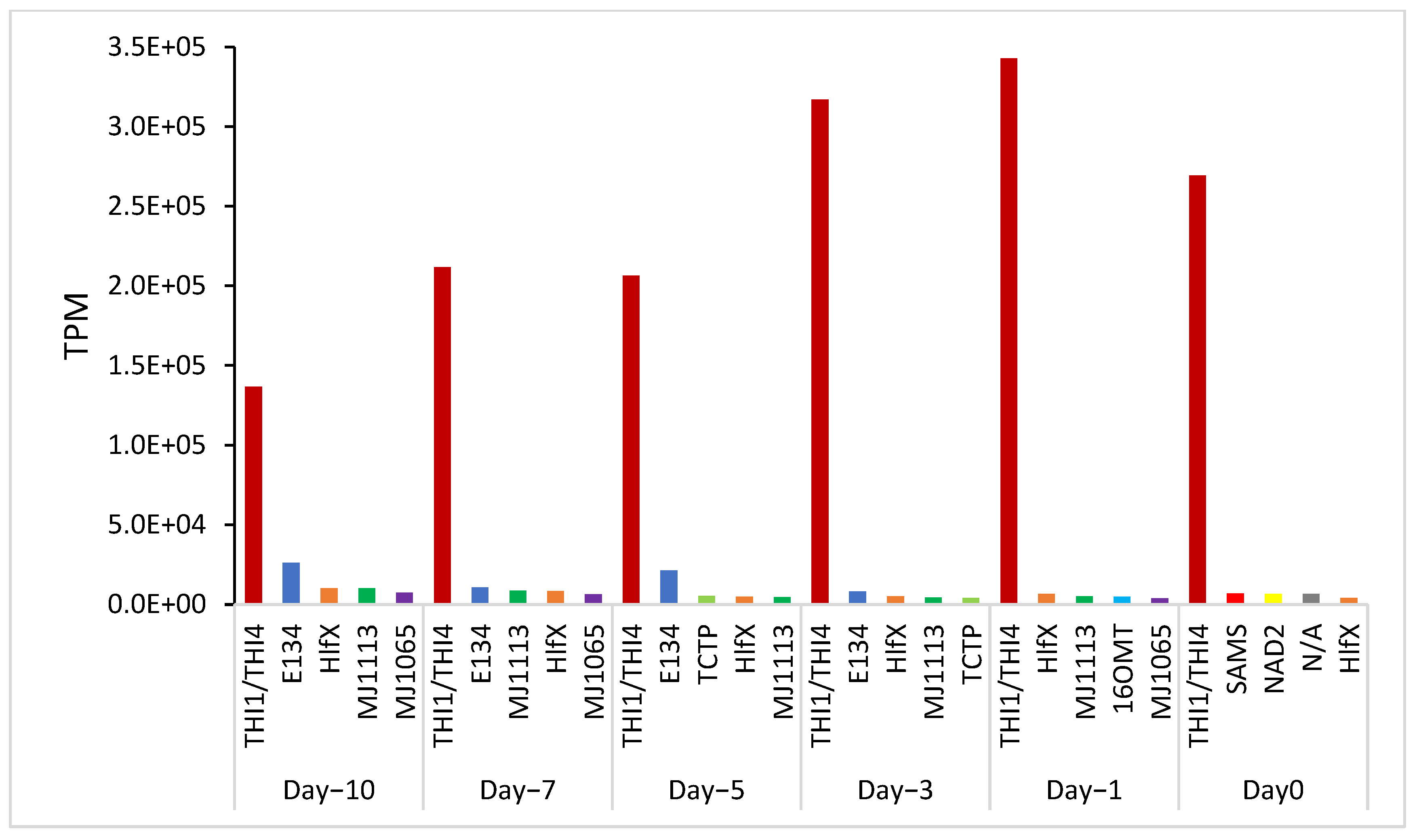
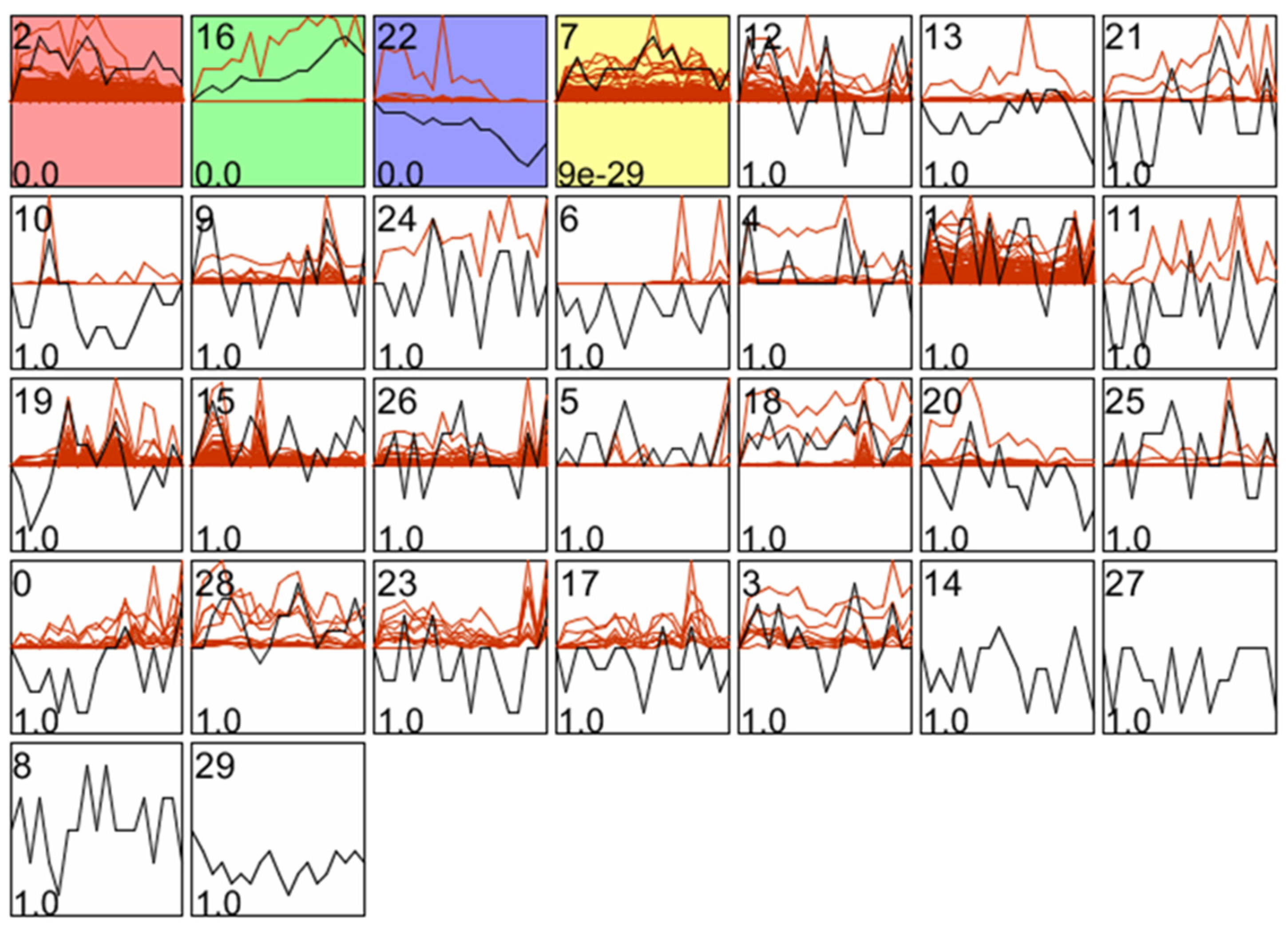
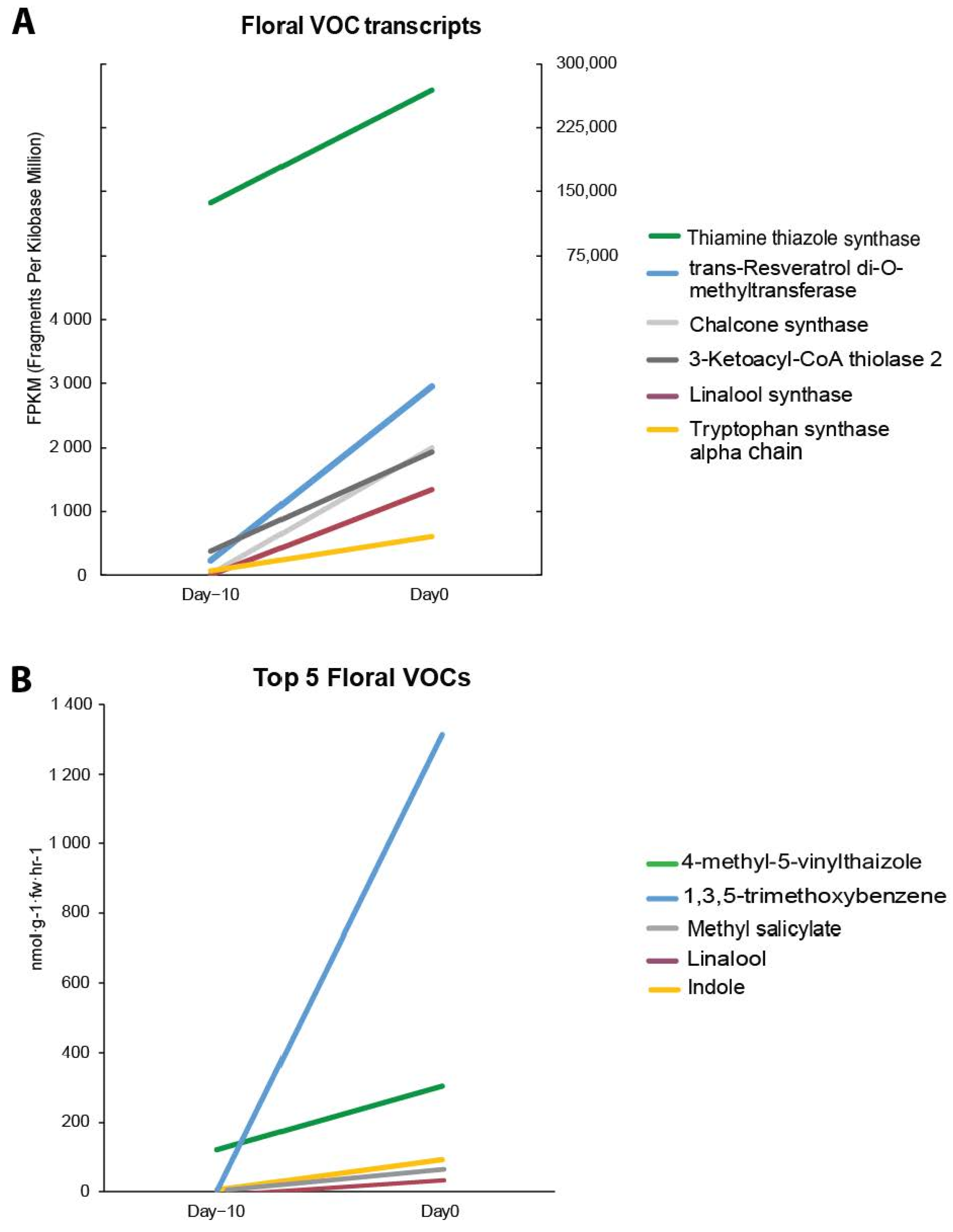
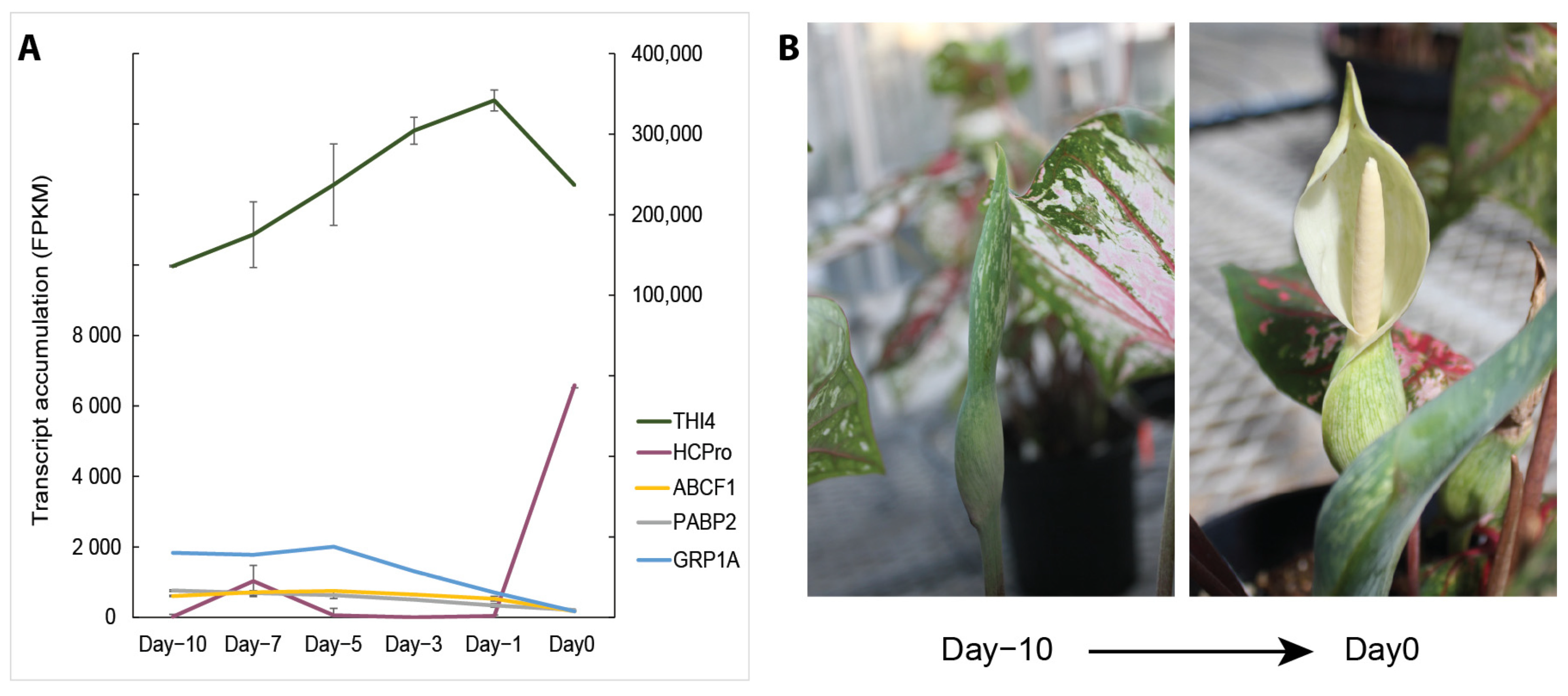
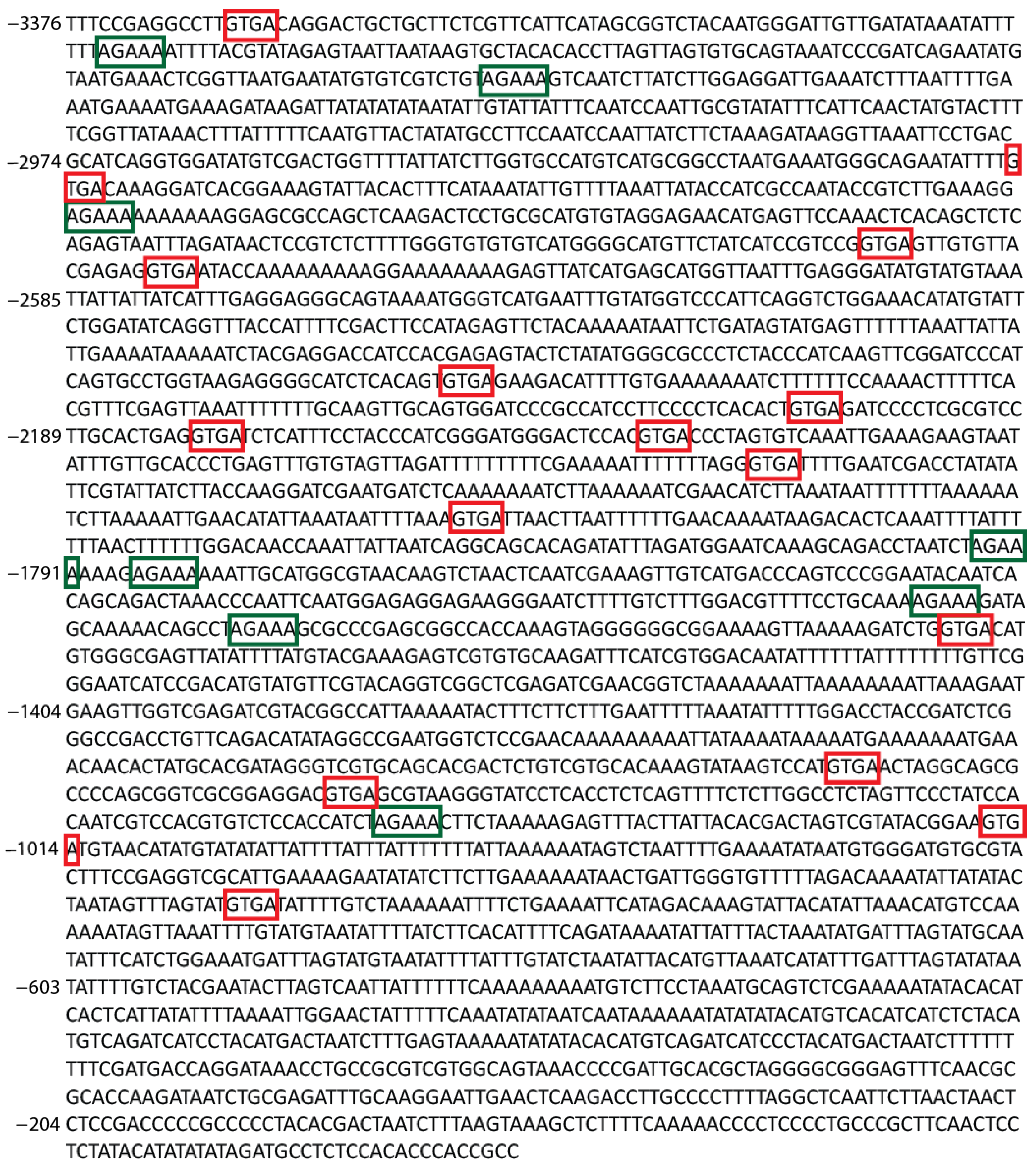
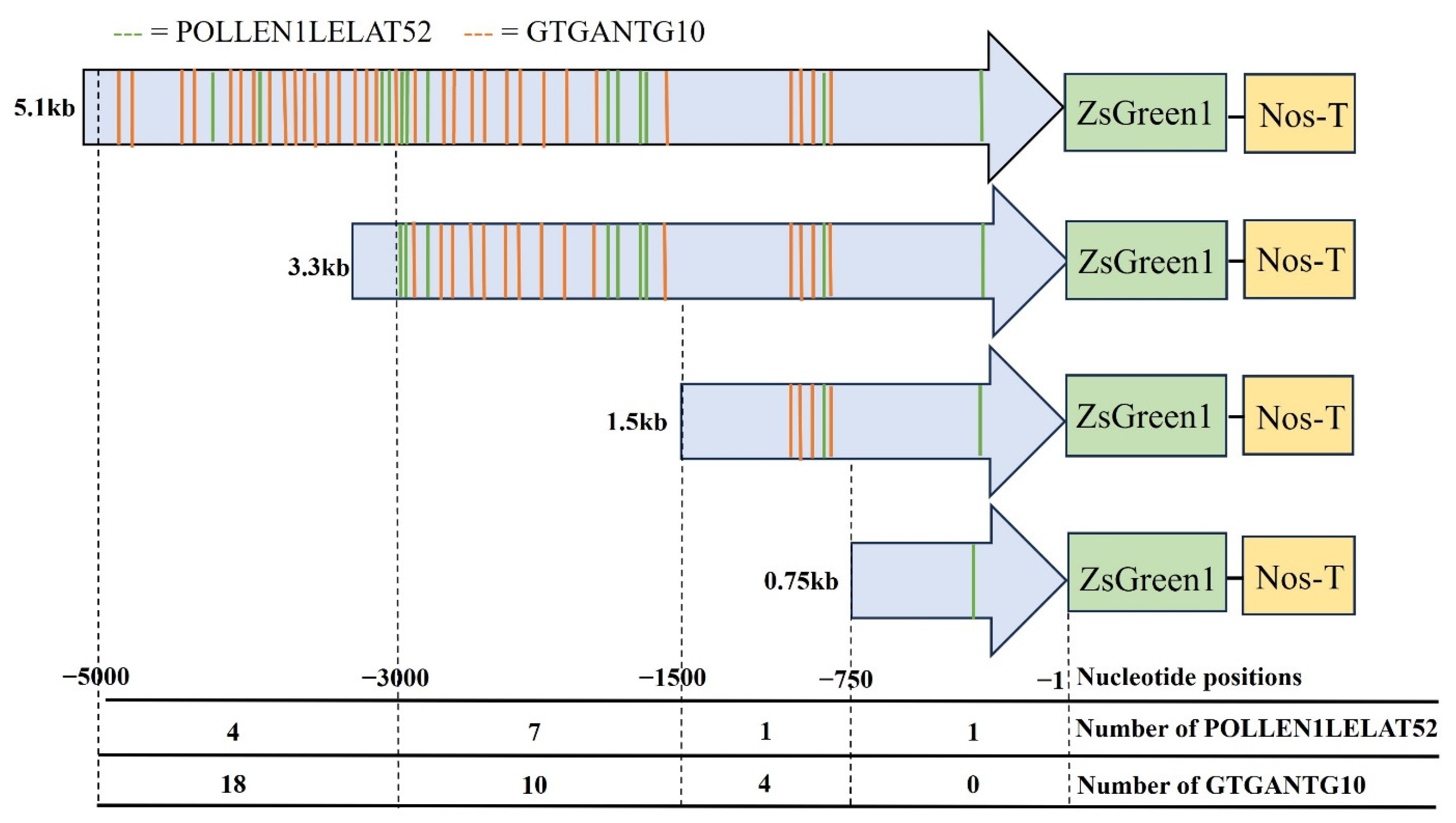
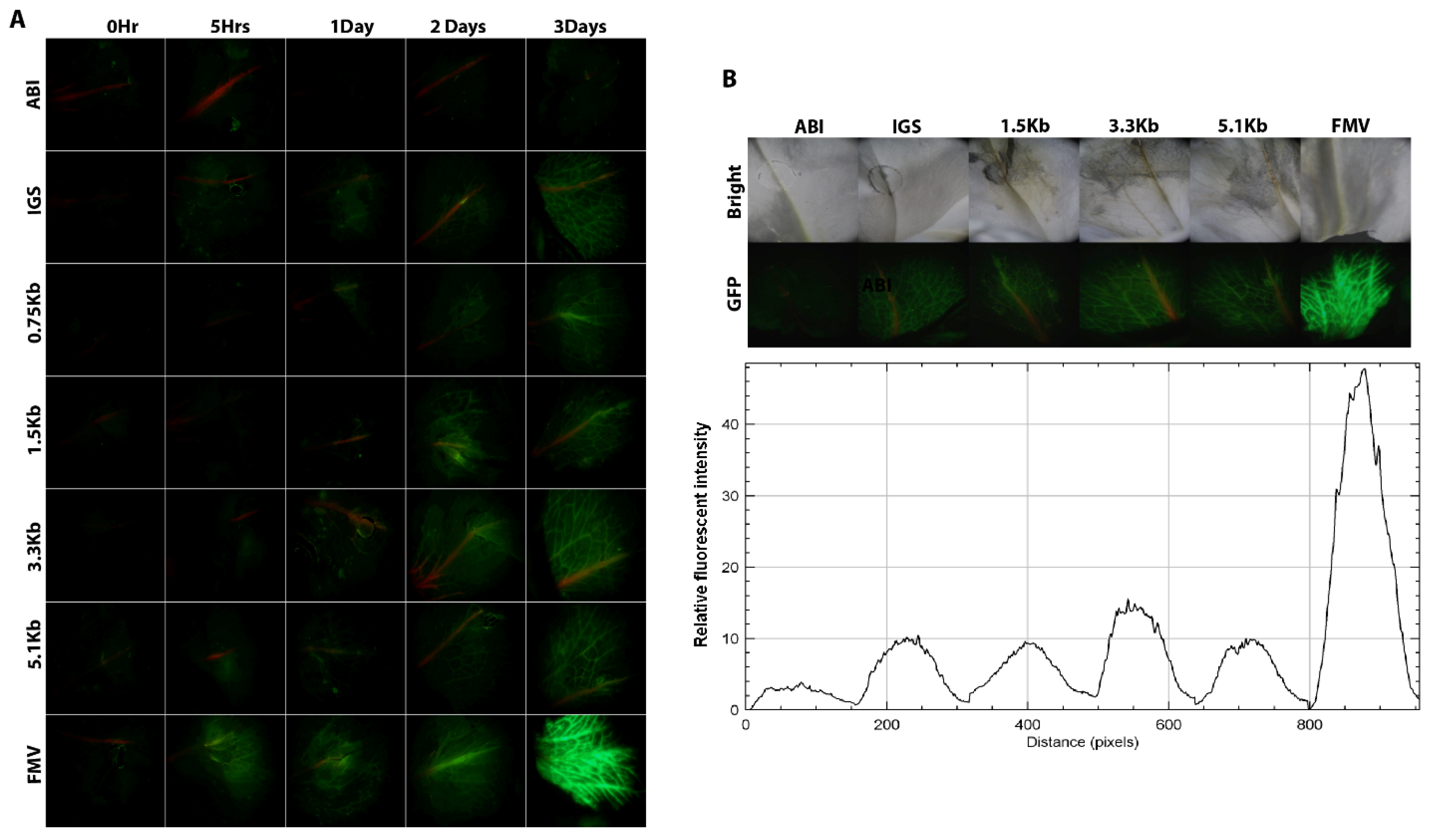
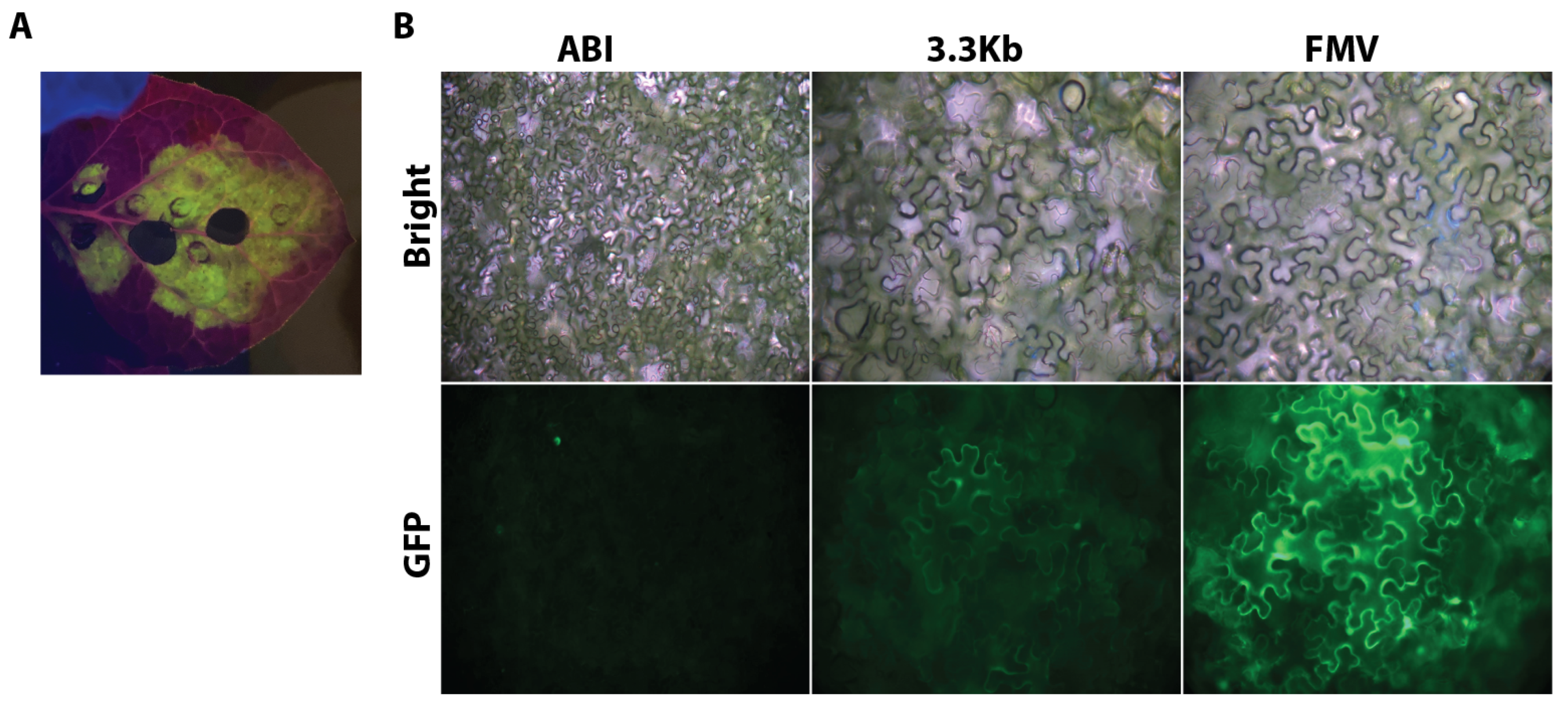
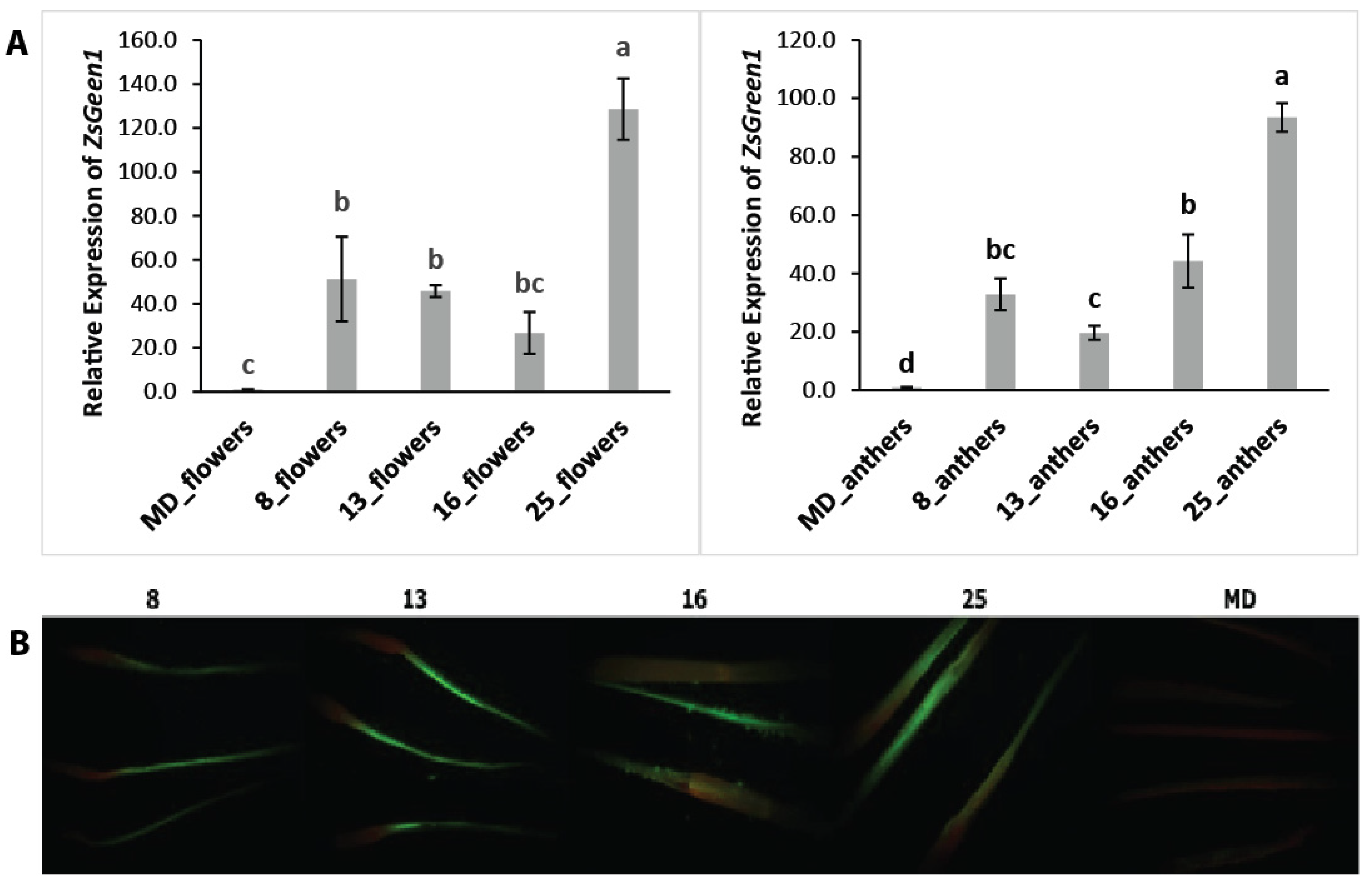
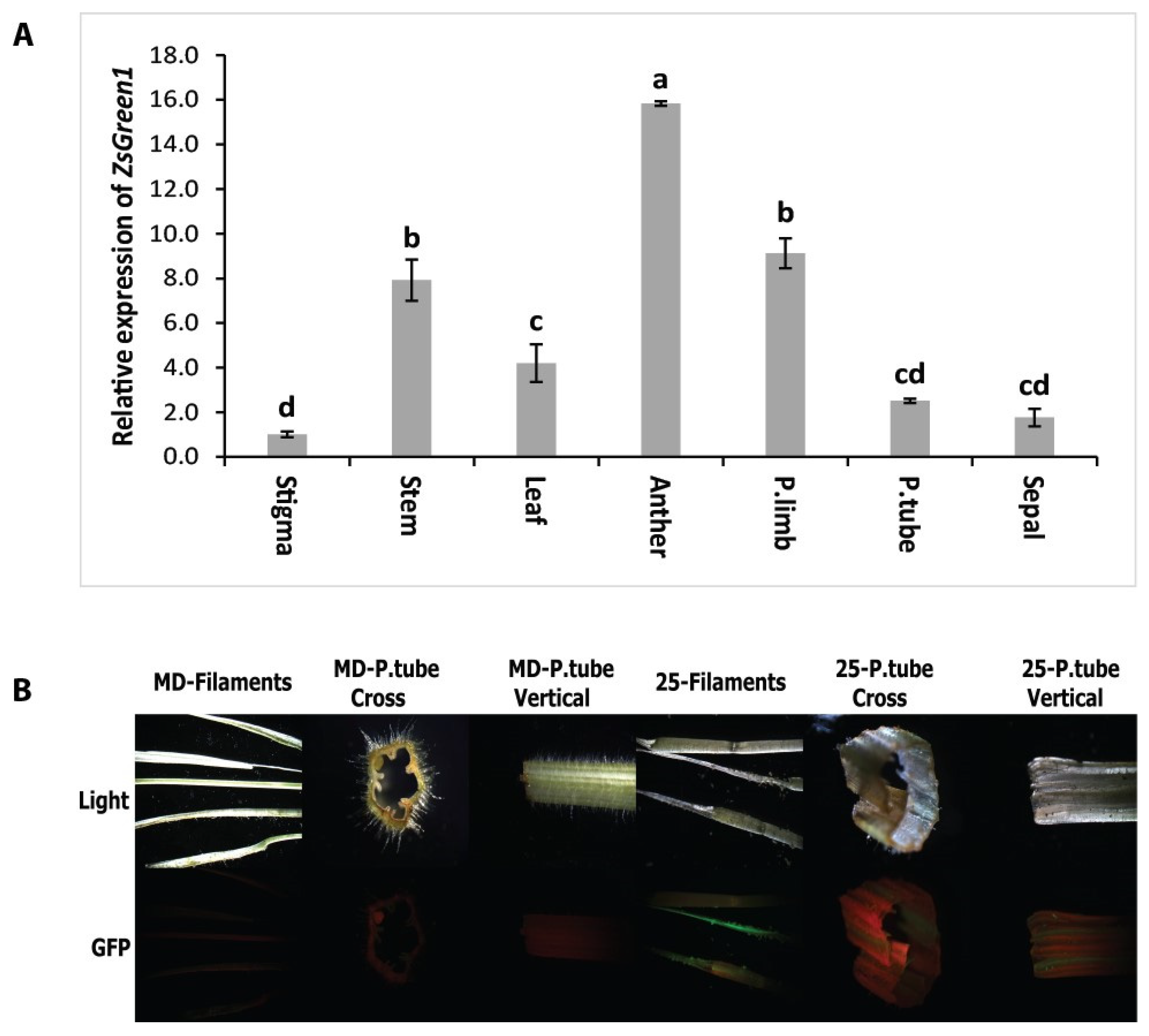
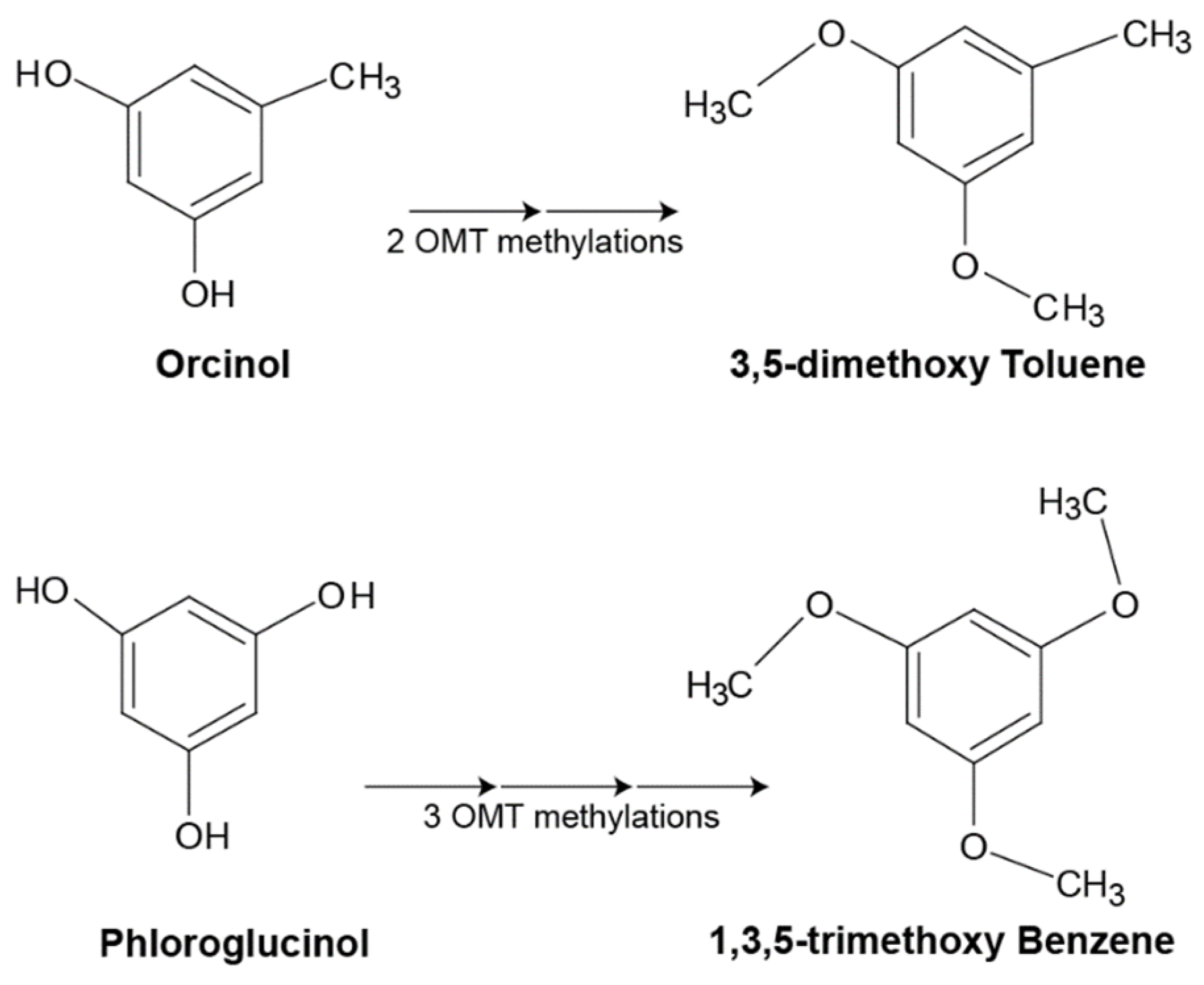
| Gene Names | Gene Description | Transcript Expression Increase (Counts) |
|---|---|---|
| HcPro | Polyprotein | 6496.03 |
| MYB305 | Myb-related protein 305-like | 1918.39 |
| ASG4/RVE3 | Transcription factor REVEILLE 3 | 1408.32 |
| AG1 | Floral homeotic protein AGAMOUS | 764.23 |
| NAC047 | NAC domain-containing protein | 718.10 |
| ILL1 | IAA-amino acid hydrolase ILR1 | 602.33 |
| MYB1R1 | Transcription factor MYB1R1 | 275.45 |
| ZAT5 | Zinc finger protein | 274.07 |
| NAC002 | NAC domain-containing protein 2 | 267.89 |
| CAF1-11 | Putative CCR4-associated factor | 241.46 |
| NAC48 | NAC domain-containing protein | 143.84 |
| NAC21 | NAC domain-containing protein 21/22 | 121.13 |
| NAC68 | NAC domain-containing protein 68 | 119.79 |
| EREBP | EREBP-like factor | 105.17 |
| MYBP | Transcription factor MYB, plant | 95.03 |
| NAC21 | NAC domain-containing protein 21/22 | 91.09 |
| EIN3 | Ethylene-insensitive protein 3 | 78.60 |
| bHLH13 | Transcription factor | 73.69 |
| bHLH146 | Transcription factor bHLH146-like | 66.49 |
| RsfS | Ribosomal silencing factor RsfS | 62.47 |
| Gene Names | Gene Description | Transcript Expression Decrease (Counts) |
|---|---|---|
| GRP1A | Glycine-rich RNA-binding protein | −1386.71 |
| PABP2 | Polyadenylate-binding protein 2 | −568.98 |
| ABCF1 | ABC transporter F family member 1 | −455.91 |
| IAA27 | Auxin-responsive protein | −270.42 |
| SPL13 | Squamosa promoter-binding-like protein 13 | −227.67 |
| CPN60/groEL | Rubisco large subunit-binding protein beta, chloroplast-like | −218.24 |
| SAHH1 | Adenosyl homocysteinase 1 | −188.89 |
| CPN60 | Chaperonin CPN60-2, mitochondrial | −181.68 |
| IAA27 | Auxin-responsive protein | −175.23 |
| CPN60/groEL | Rubisco large subunit-binding protein beta, chloroplast-like | −172.44 |
| HDT2 | Histone deacetylase HDT2 | −160.05 |
| HDT2 | Histone deacetylase HDT2 | −126.55 |
| ARF15 | Auxin response factor 15 | −106.02 |
| WLIM1 | LIM domain-containing protein | −103.82 |
| CPN60/groEL | Rubisco large subunit-binding protein beta, chloroplast-like | −93.12 |
| RH15 | DEAD-box ATP-dependent RNA helicase 56 | −81.59 |
| ZF-HD | Zinc-finger homeodomain protein | −76.05 |
| AP3 | Floral homeotic protein APETALA 3 | −75.05 |
| RNP1 | Heterogeneous nuclear ribonucleoprotein 1 | −72.78 |
| ARF7 | Auxin response factor | −71.05 |
Disclaimer/Publisher’s Note: The statements, opinions and data contained in all publications are solely those of the individual author(s) and contributor(s) and not of MDPI and/or the editor(s). MDPI and/or the editor(s) disclaim responsibility for any injury to people or property resulting from any ideas, methods, instructions or products referred to in the content. |
© 2024 by the authors. Licensee MDPI, Basel, Switzerland. This article is an open access article distributed under the terms and conditions of the Creative Commons Attribution (CC BY) license (https://creativecommons.org/licenses/by/4.0/).
Share and Cite
Kim, J.Y.; Sigler, C.L.; Cho, K.H.; Gennaro, M.D.; Ellsworth, M.S.; Colquhoun, T.A. Exploration of Thiamin thiazole synthase (THI4) Expression and Transcriptomes Involved in the Floral Volatiles of Caladium bicolor. Horticulturae 2024, 10, 810. https://doi.org/10.3390/horticulturae10080810
Kim JY, Sigler CL, Cho KH, Gennaro MD, Ellsworth MS, Colquhoun TA. Exploration of Thiamin thiazole synthase (THI4) Expression and Transcriptomes Involved in the Floral Volatiles of Caladium bicolor. Horticulturae. 2024; 10(8):810. https://doi.org/10.3390/horticulturae10080810
Chicago/Turabian StyleKim, Joo Young, Cindy L. Sigler, Keun H. Cho, Madelyn D. Gennaro, Mara S. Ellsworth, and Thomas A. Colquhoun. 2024. "Exploration of Thiamin thiazole synthase (THI4) Expression and Transcriptomes Involved in the Floral Volatiles of Caladium bicolor" Horticulturae 10, no. 8: 810. https://doi.org/10.3390/horticulturae10080810
APA StyleKim, J. Y., Sigler, C. L., Cho, K. H., Gennaro, M. D., Ellsworth, M. S., & Colquhoun, T. A. (2024). Exploration of Thiamin thiazole synthase (THI4) Expression and Transcriptomes Involved in the Floral Volatiles of Caladium bicolor. Horticulturae, 10(8), 810. https://doi.org/10.3390/horticulturae10080810






